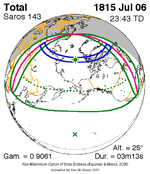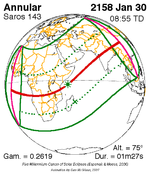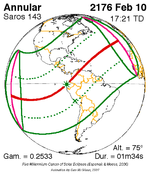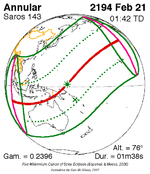Solar eclipse of August 19, 1887
| Solar eclipse of August 19, 1887 | |
|---|---|
| Type of eclipse | |
| Nature | Total |
| Gamma | 0.6312 |
| Magnitude | 1.0518 |
| Maximum eclipse | |
| Duration | 230 s (3 min 50 s) |
| Coordinates | 50°36′N 111°54′E / 50.6°N 111.9°E |
| Max. width of band | 221 km (137 mi) |
| Times (UTC) | |
| Greatest eclipse | 5:32:05 |
| References | |
| Saros | 143 (16 of 72) |
| Catalog # (SE5000) | 9251 |
A total solar eclipse occurred on Friday, 19 August 1887. A solar eclipse occurs when the Moon passes between Earth and the Sun, thereby totally or partly obscuring the image of the Sun for a viewer on Earth. A total solar eclipse occurs when the Moon's apparent diameter is larger than the Sun's, blocking all direct sunlight, turning day into darkness. Totality occurs in a narrow path across Earth's surface, with the partial solar eclipse visible over a surrounding region thousands of kilometres wide. It was visible across Europe, Asia, and Japan.
Observations
The Russian chemist Dmitri Mendeleev ascended in a balloon near Moscow to observe this eclipse.

|
 Partiality at sunrise from Berlin, Germany |
Russian writer Anton Chekhov published the short story "From the Diary of a Hot-Tempered Man" six weeks before the eclipse passed through Russia. The story includes a major section about the frustrations of a man who is trying to make a great variety of observations during the short interval of totality. In the story the eclipse date is given as 7 August 1887, but this is not an error. This is the correct date on the Julian Calendar, then in force in Russia, which did not convert to the Gregorian calendar until after the establishment of the USSR.
Related eclipses
Solar 143
This eclipse is a part of Saros series 143, repeating every 18 years, 11 days, and containing 72 events. The series started with a partial solar eclipse on March 7, 1617. It contains total eclipses from June 24, 1797 through October 24, 1995; hybrid eclipses from November 3, 2013 through December 6, 2067; and annular eclipses from December 16, 2085 through September 16, 2536. The series ends at member 72 as a partial eclipse on April 23, 2897. Its eclipses are tabulated in three columns; every third eclipse in the same column is one exeligmos apart, so they all cast shadows over approximately the same parts of the Earth.
The longest duration of totality was produced by member 16 at 3 minutes, 50 seconds on August 19, 1887, and the longest duration of annularity will be produced by member 51 at 4 minutes, 54 seconds on September 6, 2518. All eclipses in this series occur at the Moon’s ascending node of orbit.[1]
| Series members 12–33 occur between 1801 and 2200: | ||
|---|---|---|
| 12 | 13 | 14 |
 July 6, 1815 |
 July 17, 1833 |
 July 28, 1851 |
| 15 | 16 | 17 |
 August 7, 1869 |
 August 19, 1887 |
 August 30, 1905 |
| 18 | 19 | 20 |
 September 10, 1923 |
 September 21, 1941 |
 October 2, 1959 |
| 21 | 22 | 23 |
 October 12, 1977 |
 October 24, 1995 |
 November 3, 2013 |
| 24 | 25 | 26 |
 November 14, 2031 |
 November 25, 2049 |
 December 6, 2067 |
| 27 | 28 | 29 |
 December 16, 2085 |
 December 29, 2103 |
 January 8, 2122 |
| 30 | 31 | 32 |
 January 20, 2140 |
 January 30, 2158 |
 February 10, 2176 |
| 33 | ||
 February 21, 2194 | ||
Notes
- ^ "NASA - Catalog of Solar Eclipses of Saros 143". eclipse.gsfc.nasa.gov.
References
- NASA graphic
- Googlemap
- NASA Besselian elements
- American Eclipse Expedition to Japan: The Total Solar Eclipse of 1887 "Preliminary Report of Prof. David P. Todd, Astronomer in Charge of the Expedition." Published by the Observatory Amherst, Mass., 1888
- Mabel Loomis Todd (1900). Total Eclipses of the Sun. Little, Brown.
- The total solar eclipse of August 19, 1887 Monthly Notices of the Royal Astronomical Society, Vol. 48, p. 202
- Sketchs of Solar Corona August 19, 1887
- Solar eclipse of August 19, 1887 in Russia




